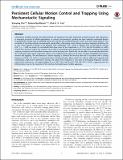Persistent Cellular Motion Control and Trapping Using Mechanotactic Signaling
Author(s)
Zhu, Xiaoying; Bouffanais, Roland; Yue, Dick K. P.
DownloadZhu-2014-Persistent cellular.pdf (808.8Kb)
PUBLISHER_CC
Publisher with Creative Commons License
Creative Commons Attribution
Terms of use
Metadata
Show full item recordAbstract
Chemotactic signaling and the associated directed cell migration have been extensively studied owing to their importance in emergent processes of cellular aggregation. In contrast, mechanotactic signaling has been relatively overlooked despite its potential for unique ways to artificially signal cells with the aim to effectively gain control over their motile behavior. The possibility of mimicking cellular mechanotactic signals offers a fascinating novel strategy to achieve targeted cell delivery for in vitro tissue growth if proven to be effective with mammalian cells. Using (i) optimal level of extracellular calcium ([Ca2[superscript +] ][subscript ext] = 3 mM) we found, (ii) controllable fluid shear stress of low magnitude (σ < 0.5 Pa), and (iii) the ability to swiftly reverse flow direction (within one second), we are able to successfully signal Dictyostelium discoideum amoebae and trigger migratory responses with heretofore unreported control and precision. Specifically, we are able to systematically determine the mechanical input signal required to achieve any predetermined sequences of steps including straightforward motion, reversal and trapping. The mechanotactic cellular trapping is achieved for the first time and is associated with a stalling frequency of 0.06 ~ 0.1 Hz for a reversing direction mechanostimulus, above which the cells are effectively trapped while maintaining a high level of directional sensing. The value of this frequency is very close to the stalling frequency recently reported for chemotactic cell trapping [Meier B, et al. (2011) Proc Natl Acad Sci USA 108:11417–11422], suggesting that the limiting factor may be the slowness of the internal chemically-based motility apparatus.
Date issued
2014-09Department
Massachusetts Institute of Technology. Department of Mechanical EngineeringJournal
PLoS ONE
Publisher
Public Library of Science
Citation
Zhu, Xiaoying, Roland Bouffanais, and Dick K. P. Yue. “Persistent Cellular Motion Control and Trapping Using Mechanotactic Signaling.” Edited by Ming Dao. PLoS ONE 9, no. 9 (September 10, 2014): e105406.
Version: Final published version
ISSN
1932-6203